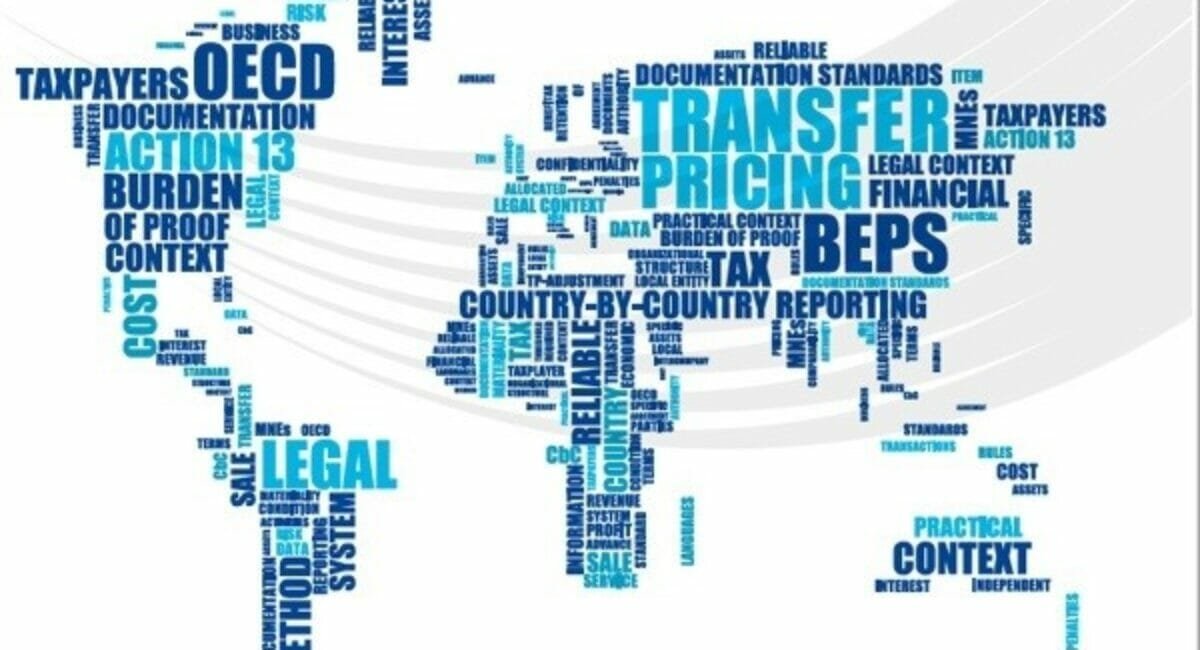LEGALLANDS LLP global transfer pricing practice, in partnership with International Tax Review, is pleased to present the 2019 edition of the Transfer Pricing Controversy Guide, a discussion and overview of the leading issues, challenges and opportunities around transfer pricing (TP) controversy.
WHAT IS TRANSFER PRICING?
Transfer pricing, for tax purposes, is the pricing of intercompany transactions that take place between affiliated businesses. The transfer pricing process determines the amount of income that each party earns from that transaction.
An exercise largely carried out for Tax Minimization across the group. As long as the group is controlling the funds, it does not matter where they are parked.
Taxpayers and the taxing authorities focus exclusively on related-party transactions, which are called controlled transactions, and have no direct impact on independent party transactions, which are termed as uncontrolled transactions.
DEFINITION
“A transfer price is a price, adopted for bookkeeping purposes, which is used to value transactions between affiliated enterprises integrated under the same management at artificially high or low levels in order to effect an unspecified income payment or capital transfer between those enterprises.” –OECD
Commercial transactions between the different parts of the multinational groups may not be subject to the same market forces shaping relations between the two independent firms. One party transfers to other goods or services, for a price. That price is known as “transfer price”
This may be arbitrary and dictated, with no relation to cost and added value, diverge from the market forces.
Transfer price is, thus, a price that represents the value of good; or services between independently operating units of an organization. But, the expression “transfer pricing” generally refers to prices of transactions between associated enterprises which may take place under conditions differing from those taking place between independent enterprises. It refers to the value attached to transfers of goods, services, and technology between related entities. It also refers to the value attached to transfers between unrelated parties which are controlled by a common entity.
Suppose a company A purchases goods for 100 rupees and sells it to its associated company B in another country for 200 rupees, who in turn sells in the open market for 400 rupees. Had A sold it directly, it would have made a profit of 300 rupees. But by routing it through B, it restricted it to 100 rupees, permitting B to appropriate the balance. The transaction between A and B is arranged and not governed by market forces. The profit of 200 rupees is, thereby, shifted to the country of B. The goods is transferred on a price (transfer price) which is arbitrary or dictated (200 hundred rupees), but not on the market price (400 rupees).
Thus, the effect of transfer pricing is that the parent company or a specific subsidiary tends to produce insufficient taxable income or excessive loss on a transaction. For instance, profits accruing to the parent can be increased by setting high transfer prices to siphon profits from subsidiaries domiciled in high tax countries, and low transfer prices to move profits to subsidiaries located in low tax jurisdiction. As an example of this, a group that manufactures products in high tax countries may decide to sell them at a low profit to its affiliate sales company based in a tax haven country. That company would in turn sell the product at an arm’s length price and the resulting (inflated) profit would be subject to little or no tax in that country. The result is revenue loss and also a drain on foreign exchange reserves. – Income Tax Department
“ARM’S LENGTH PRICE” means a price which is applied or proposed to be applied in a transaction between persons other than associated enterprises, in uncontrolled conditions;
“Inter-national transaction”
means a transaction between two or more associated enterprises, either or both of whom are non-residents, in the nature of purchase, sale or lease of tangible or intangible property, or provision of services, or lending or borrowing money, or any other transaction having a bearing on the profits, income, losses or assets of such enterprises, and shall include a mutual agreement or arrangement between two or more associated enterprises for the allocation or apportionment of, or any contribution to, any cost or expense incurred or to be incurred in connection with a benefit, service or facility provided or to be provided to anyone or more of such enterprises.
(2) A transaction entered into by an enterprise with a person other than an associated enterprise shall, for the purposes of sub-section (1), be deemed to be an international transaction entered into between two associated enterprises, if there exists a prior agreement in relation to the relevant transaction between such other person and the associated enterprise, or the terms of the relevant transaction are determined in substance between such other person and the associated enterprise where the enterprise or the associated enterprise or both of them are non-residents irrespective of whether such other person is a non-resident or not. (defined as per section 92, 92C, 92D, and 92E)
OBJECT OF TRANSFER PRICING REGULATIONS
In India, transfer pricing regulations date back to 1939 which were adopted in the 1961 Act. In view of the increasing participation of MNEs in the economic life of India, particularly, after the liberalization of the Indian economy in 1991, a need was felt to provide a detailed statutory framework which can lead to a reasonable, fair, and equitable profit allocation and tax to India. Accordingly, sections 92 to 92F were introduced with effect from 01.04.2002 along with rules 10A to 10E notified on 21.08.2002. These provisions covered the meaning of the terms ‘international transaction’ and ‘associated enterprises’ besides providing methods for computation of arm’s length price and documentation requirements. The provisions also created an authority named Transfer Pricing Officer for the specialized role of determining arm’s length price after the assessing officer has made a reference of an international transaction to the above authority. This process was completed after extensive consultations and feedback from all the stakeholders.
The basic intention underlying these transfer pricing regulations was to prevent shifting out of profits from India by manipulating prices charged in international transactions, thereby eroding the country’s tax base.
TRANSACTIONS SUBJECT TO TRANSFER PRICING
The following are some of the typical international transactions which are governed by the transfer pricing rules:
- Sale of finished goods;
- Purchase of raw material;
- Purchase of fixed assets;
- Sale or purchase of machinery etc.
- Sale or purchase of Intangibles.
- Reimbursement of expenses paid/received;
- IT Enabled Services;
- Support services;
- Software Development services;
- Technical Service fees;
- Management fees;
- Royalty fee;
- Corporate Guarantee fees;
- Loan received or paid.
Also Read: External Commercial Borrowings (ECB) in case of Foreign Loan
PURPOSES OF TRANSFER PRICING
The key objectives behind having transfer pricing are:
- Generating separate profit for each of the divisions and enabling performance evaluation of each division separately.
- Transfer prices would affect not just the reported profits of every center, but would also affect the allocation of a company’s resources (Cost incurred by one center will be considered as the resources utilized by them).
THE BASIC ISSUES IN THE ‘TRANSFER PRICING’:
- Tax Mitigation
- Jurisdictional Issues
- Comparable Data/Information
- Availability of Qualitative Data
- Application of Data Rules
- Risk Related issues
- Valuation Issues
- Diversion of Funds
- Borrowing or Lending
RATIONALE
In a globalized economy, there has been an emergence of Multi-National Enterprises, wherein the parent company may be in one country while its various subsidiaries and Branches/Associated Enterprises will be spread over in different countries.
- This has led to an increasing volume of transactions within an MNE Group, which are also called Intra Group Transactions. Since these Intra Group Transactions are not purely governed by market forces but are driven by the Group Companies’ common interests, the pricing of such Intra Group Transactions often becomes a subject of controversy.
- MNE/MNCs try to distribute their profits amongst the various companies within the Group located in different countries.
Conceptual Framework of Transfer Pricing depends on the Permanent Establishment (PE), Business Connection, Enterprise, Place of Effective Management (POEM) – a concept introduced by the Finance Act, 2017, Associated Enterprise (AE) and International Transactions that are discussed in a nutshell herewith.
WHY ORGANIZATIONS NEED TO UNDERSTAND TRANSFER PRICING
- For the purpose of management accounting and reporting, multinational companies (MNCs) have some amount of discretion while defining how to distribute the profits and expenses to the subsidiaries located in various countries.
- The profitability of a subsidiary depends on the prices at which the inter-company transactions occur. These days the inter-company transactions are facing increased scrutiny by the governments. Here, when transfer pricing is applied, it could impact shareholders’ wealth as this influences company’s taxable income and its after-tax, free cash flow.
- It is important that a business having cross-border intercompany transactions should understand the transfer pricing concept, particularly for the compliance requirements as per law, and to eliminate the risks of non-compliance.
TRANSFER PRICING METHODOLOGIES
- Comparable Uncontrolled Price (CUP) Method
- Resale Price Method or Resale Minus Method
- Cost Plus Method
- Profit Split Method
- Transaction Net Margin
- Another method – rationale on TP was on arm’s length
- Most Appropriate Method (MAM) – Rule 10C of Income Tax Rules
STEPS INVOLVED IN TRANSFER PRICING
- Maintenance of TP study report
- Reference to a TPO
- Transfer Pricing Order
- Draft Assessment Order
- Reference to Dispute Resolution Panel
- Directions of DRP
- Final Assessment Order
PROBLEMS ASSOCIATED WITH TRANSFER PRICING
There are quite a few problems associated with transfer prices. Some of these issues include:
- Different opinions among organizational divisions
- Additional time, costs and manpower would be required for executing the transfer prices and designing the accounting system to match the requirements of transfer pricing rules.
- Arm’s length prices might cause dysfunctional behavior among the managers of organizational units.
- For some of the divisions or departments, for instance, a service department, arm’s length prices don’t work equally well as such departments don’t offer measurable benefits.
- The transfer pricing issue in a multinational setup is very complicated.
DISPUTE RESOLUTION MECHANISMS UNDER TRANSFER PRICING
Early finalization of tax liability is a prerequisite for any effective tax system enabling early collection of revenues legally due.
The dispute resolution mechanisms applicable to the taxes on income relating to cross-border transactions comprise domestic mechanisms and the mutual agreement procedures under the tax treaties. The domestic mechanism consists of appeals and judicial reviews.
The mutual agreement procedure to resolve the issues arising under the tax treaties is the other limb of the mechanism. It is for the taxpayer to choose the forum which will be the most effective, depending upon the facts and circumstances of his case.
The first appellate authority is the CIT(A). However, any person in whose case there is variation in the income or loss returned as per the order proposed by the assessing officer, on the basis of the computation by the TPO of the arm’s length price as also a foreign company, the draft of the order of assessment which is prejudicial to the interest of the assessee and the variation is not acceptable to the taxpayer, he can file his objections to the Dispute Resolution Panels (DRP) based in Delhi and Mumbai.
This Panel comprises three Commissioners who are its full-time members. The powers of the DRP are coterminous with those of the assessing officer. The DRP is empowered to issue such directions as he thinks fit after considering the draft order, the objections by the assessee, and the evidence furnished or collected.
An order passed by an assessing officer pursuant to the directions of the DRP is appealable before the Tribunal which is the final fact-finding authority.
An appeal lies to the High Court from any order of Tribunal involving a substantial question of law. An appeal is provided to the Supreme Court from any judgment of High Court subject to certificate of fitness by the High Court certifying that the case involves a substantial question of law of general importance. India has developed a sophisticated body of case laws.
- Article 25 of the Model Double Taxation Convention provides an alternative mechanism in the form of Mutual Agreement Procedure (MAP) irrespective of the remedies provided by the domestic law of the respective States. It is the responsibility of tax administrations who are parties to tax Conventions to ensure that the taxpayers are not subjected to double taxation, do not avail of unintended double non-taxation, and are not subject to taxation not in accordance with the provisions of a tax Convention. MAP is intended to resolve disputes in respect of these issues. A large number of cases under MAP are in the context of transfer pricing problems and the issue of the existence of PE.
- Advance Pricing Agreement (APA) is an arrangement in respect of certain specified transactions that determine in advance for a specified period, the appropriate criteria for determining the arm’s length price of an international transaction, or specifies the manner in which such price is to be determined. This is a dispute prevention mechanism. The main purpose of an APA is to supplement traditional administrative, judicial, and treaty mechanisms for resolving transfer pricing issues in an environment of co-operative and non-adversarial negotiation for resolution of transfer pricing issues.
- There are three types of APAs, namely, unilateral, bilateral, and multilateral. This process is initiated with pre-filing consultation followed by the furnishing of an APA application, due diligence, analysis of the terms of an application by the APA team, negotiation between the competent authorities in the cases of bilateral or multilateral APA, acceptance or rejection of an APA application, entering into APA, its implementation, filing of annual compliance report by the taxpayer and compliance audit by the tax authorities concerned. This may result in renewal, revocation, revision, or cancellation of the APA.
This article was written by Aakriti Tuli of LEGALLANDS LLP.© 2020. For information, contact LEGALLANDS LLP. This communication contains general information only, and none of LEGALLANDS LLP, its member firms, or their related entities (collectively, the “LEGALLANDS network”) is, by means of this communication, rendering professional advice or services. Before making any decision or taking any action that may affect your finances or your business, you should consult a qualified professional adviser. No entity in the LEGALLANDS network shall be responsible for any loss whatsoever sustained by any person who relies on this communication.






